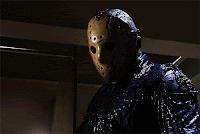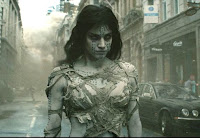If you haven’t seen the film I titled this week’s rant after, go see it now. Phenomenal movie by Christopher Nolan, the guy who did The Dark Knight, based off the book by Christopher Priest. Hop over to Netflix and rearrange the queue. If nothing else, go over to Jurassic Punk and download the trailer. The film is fantastic, but the trailer actually gives us everything I want to talk about this week.
A common term that gets thrown around in Hollywood is three-act structure. To be honest, it gets used a lot by people who don’t know much about storytelling, and they often try to pin this structure down to a rigid, unyielding formula (which tends to result in rigid, unyielding films). We have this structure in prose fiction, too, where we call it establishing the norm, introducing conflict, followed by resolution. Even in a magic trick, there’s the pledge, the turn, and the prestige (as explained by Michael Caine in the above-mentioned trailer).
At its simplest, any sort of storytelling has a beginning, a middle, and an end. To be more exact, every story needs these three stages. Not just in terms of page count, but in the way it develops. If your story’s done right, any audience member can tell you almost exactly when and where these parts begin and end.
On the other hand, a story that doesn’t have these three parts has a sort of… meandering quality to it. Characters fall into inaction, or they leap into full-tilt action that doesn’t seem to have any purpose to it. They run or drive aimlessly, or sometimes we get to see them repeat the same actions two or thee times.
This generally comes from writers only having one or two parts of a story. Maybe they had a great opening and a cool middle, but didn’t know how to end it. Or they came up with a cool opening and a clever end, but never figured out how those points connect. I’ve even seen a few folks write a very cool opening… and nothing else. There was a great set up and then the story sort of spiraled off into… nowhere.
Here’s a great little way to look at this rule of thumb. Jim Shooter, who was Editor-in-Chief at Marvel Comics back in the day, had a wonderful example of the perfect story– the old nursery rhyme “Little Miss Muffett.” It’s got all the parts of a great literary classic. Now, drag your minds out of the gutter and follow along…
Little Miss Muffett sat on her tuffet, eating her curds and whey.
This is our beginning. We’ve introduced character, location, and action. This is also called establishing the norm. Were nothing else to happen in our story, Miss Muffett would probably just sit there all day eating spoonful after spoonful. Maybe once the sun went down she’d go home and watch the fight on pay-per-view or something, but odds are this probably would’ve been a day like any other for her.
Along came a spider, which sat down beside her.
This is the middle of our story—the second act if you will. Now we’ve got an adversary, and a set of actions which produce conflict between the adversary and our protagonist (most tuffets are only built for one, after all). Something has happened which is not part of Muffy the curd-and-whey-slayer’s normal day, and it’s going to make things change.
And frightened Miss Muffet away.
The end of the tale. The conflict has come to an end and the story has a resolution, even if it’s just Muffy lifting the hem of her dress and sprinting away. It’s not the longest third act on record, but there it is.
If you don’t want to admit you know nursery tales, look at The Matrix. The beginning is Neo in his normal life as he goes to clubs and tries to avoid agents. The middle is him waking up in “the real world,” learning new skills, and going to meet the Oracle. The end is him taking on the figurehead role they’re prepared him for (even though he’s not sure he’s ready for it) and going to rescue Morpheus. These aren’t beats I’ve selected at random or for timing reasons—they’re moments in the film when the audience immediately knows we’ve moved to a next major section of the story and in Neo’s growth as a character.
Now, there are a few little caveats to this, of course. Despite what many gurus say, three act structure is not some ironclad, unchanging rule. Many stories start in the middle and take a bit before they go back and explain the beginning. “Coming in at the action,” some folks like to call it (we talked about this a few months back in regards to horror stories). A Princess of Mars, the classic sci-fi novel by Edgar Rice Burroughs, actually begins at the very end of the tale, in the denouement, with the author inheriting a strange manuscript from his recently deceased uncle, John Carter.
All of this is fine, and there’s a great literary precedent for it. Some of my favorite stories work this way, in fact. What aspiring writers need to remember, though, that all these stories still have a beginning, middle, and end, even if they’ve been juggled around a bit in their tellings. The events have a definitive starting point. The characters have a baseline the audience sees them at. There’s a progression brought about by conflict and changes resulting from the conflict. And it all leads to a definitive conclusion.
(As a minor aside, this is why ending any story with “to be continued” immediately causes you to lose fifteen or twenty credibility points. It just means the writer hasn’t bothered with an actual ending.)
That leads us to the one question some of you have probably been wondering about since I started this little rant. Why do we need all this? What’s so important about these three parts?
They’re important because a beginning, middle, and end gives us character growth, and as I’ve said more than two or three times, good writing is about good characters. We need to see who they start off as, what changes them, and how the change affects them in the long run. Miss Muffet starts the day with her usual breakfast, but ends it fleeing in terror, probably never to return to her favorite tuffet again. Perhaps she’ll have some emotional scars and never be able to eat curds and whey again without being reminded of this terrible event. Whatever happens, we know it’s a real response that grew out of her experiences. Which makes her a memorable character.
After all, Miss Muffet’s story has been around for about four hundred years. We should all be so lucky.
So, next week, we’re going to play detective. No, it’s not like playing doctor, you perverts. We’re just going to talk a lot about motives and alibis, and how you always need them in your writing.
Speaking of which… get back to that writing, why don’t you?





